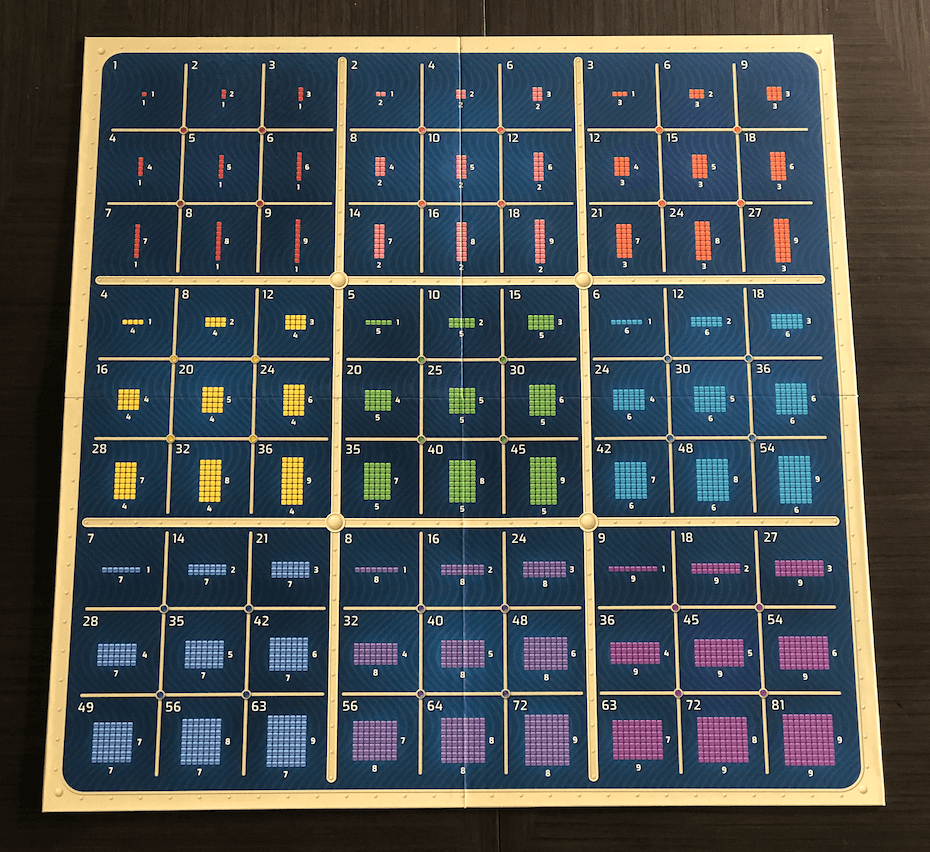How to Use this Lesson
This is meant as a general outline for how to structure a lesson around MULTI. Whether your students are in early elementary, upper elementary, middle school or above, this structure will work to help groups of students pull out the many mathematical concepts connected to playing MULTI. The lesson is also easy to adapt to various in-person or distance learning settings.
Instead of writing a lesson for each grade band such as K-2, another for 3-5, and another for middle school and beyond, I will describe the mathematics each grade band could potentially get into and leave it to the teacher to decide what concepts to guide their students through.
Also, the lesson plan could be implemented (without the second game) in about 50-60 minutes, extended to a 90 minute block periods, broken up into several sessions or even repeated to dig deeper into a topic.
If you have any questions about how to weave specific topics into a lesson or how to adapt the lesson to your setting, don’t hesitate to contact us.
Key Topics
Early Elementary (K-2)
Arrays, rectangles, area, square units, etc.
Square Numbers
Recognizing patterns and structure
Symmetry
Strategy in general, and/or for openings and endgame situations
Upper Elementary (3-5)
Arrays, rectangles, area, square units, etc.
Square Numbers
Recognizing patterns and structure
Symmetry
Strategy in general, and/or for openings and endgame situations
Multiples, common multiples
Factors, common factors
Middle School and Beyond
Arrays, rectangles, area, square units, etc.
Recognizing patterns and structure
Symmetry
Strategy in general, and/or for openings and endgame situations
Multiples, common multiples
Factors, common factors
Combinatorics
Game Theory
Computer Science, coding, machine learning, etc.
Lesson Plan
What do you notice?
What do you wonder?
Notice/Wonder (5-15 minutes)
Display the Factor Board, MULTI board, or both to your students. (Depending on your setting, you could also have each student holding a print and play board or pairs of students in front of each board.)
Ask “What do you notice?” and “What do you wonder?”
Consider using a “Think, Pair, Share” model to help generate and record a greater number of student observations.
Record Notice and Wonder on the board, document, or chart paper.
Review the Rules
Teacher-led or in small groups/partners
The Game Reveal (5-15 minutes)
“This is a game called MULTI, here are the rules…”
This could be teacher-led guided reading using a slideshow, or you could just hand out the rules and let them figure it out, or somewhere in between.
Play Time (20-30 minutes)
Give students at least enough time to finish one game which typically can last between 15-30 minutes. If students finish a game earlier than others, have them play again.
Once every pair has completed a game, you can ask everyone to pause and take a moment to think about what they noticed/wonder about the game now and/or what strategies did they and their partner use?
Strategy Talk
What’s the best strategy here? How do you know?
Sharing Strategies (10-20 minutes)
If possible, have students switch partners and share the strategies they used.
Next, have students share out their strategies with the whole group.
Record their strategies in the board, document or chart paper.
Reflection (5 minutes)
Ask students to consider the strategies shared when deciding how to play in the next game.
You could have students record and/or discuss with a partner a strategy they might try in the next game.
Play Again (20-30 minutes)
If time permits, have students play again using what they learned in the first game and strategy talk.
Switch partners if desired/possible.
Exit Ticket (5 minutes)
There are lots of possible exit tickets depending on the topics discussed in the lesson. Here are a few examples...
Describe a pattern you noticed on the MULTI board.
Where on the board do you find the multiples of 5? What about the multiples of 9?
What number comes up the most?
What numbers come up the least?
What’s a good opening move?
Describe your strategy.
Describe strategy your opponent used against you.
Show students an endgame situation and ask them to describe what they would do and why?
Show students a game situation and ask them to decide who they think will win and why?
How many different possible games are there?
Where can I get a copy of MULTI?
You can purchase the digital print and play version and table top edition in the Joyful Mathematics Shop, the table top edition is also available on Amazon.





